https://www.nti-audio.com/en/support/know-how/what-are-noise-curves
What are Noise Curves?Noise curves are used to measure and specify background noise in unoccupied buildings and spaces. In most cases, the goal is that background noise should not interfere with the purpose of the room, e.g. the noise of an office air-conditioning system and consistent noise of traffic outside the building should not interfere with telephone calls or conversations. Background noise that is annoying creates fatigue and can negatively affect productivity and safety. Too much noise also affects the ability to communicate. Therefore standard methodologies for quantifying such noise have been developed. Different rooms, locations, regulations and applications may allow different acceptable noise ratings.
Methods and StandardsFor all ambient noise measurement methods, a measured noise spectrum is superimposed on a family of contours (or curves). 
Result: NC45
Noise Rating NR(in accordance with ISO 1996) In Europe, the International Organization for Standardization (ISO) defines Noise Rating (NR) as a graphical method for assigning a single number rating to a noise spectrum. It can be used to specify the maximum acceptable level in each octave band of a frequency spectrum, or to assess the acceptability of a noise spectrum for a particular application. The method was originally proposed for use in assessing environmental noise, but it is now used frequently for describing noise from mechanical ventilation systems in buildings. The NR of the spectrum corresponds to the value of the first NR contour that is entirely above the spectrum. 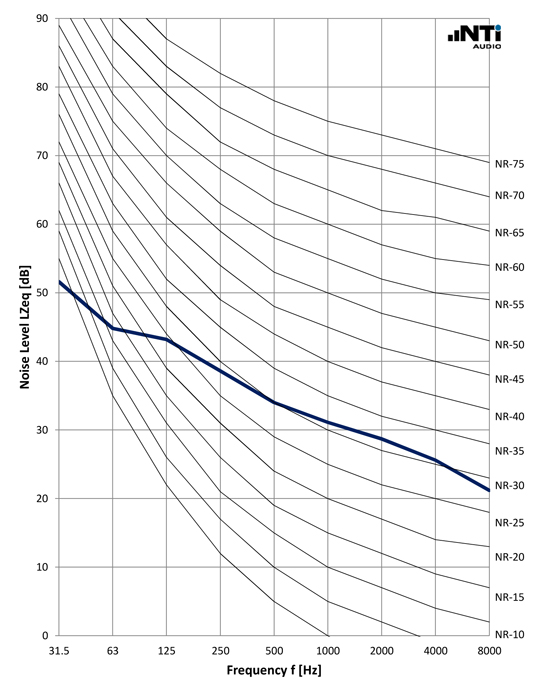
Noise Rating NR32
Noise Criteria NC(in accordance with ANSI S12.2-2008 and -1995)
The American National Standards Institute (ANSI) defines the NC rating to describe the noise in a space by examining a range of frequencies. The NC rating of a spectrum is designated as the value of the lowest NC curve above the measured octave-band spectrum. The measured noise criteria, e.g. NC30, informs that the room performs better than that. The designating number for any NC curve is, approximately, its Speech Interference Level (SIL): the average of the levels in the 500, 1000, 2000 and 4000 Hz octave bands. SIL is a simple metric, which measures the effects of noise on speech intelligibility. The XL2 Analyzer includes the tangency method adaptation in accordance with the standard. 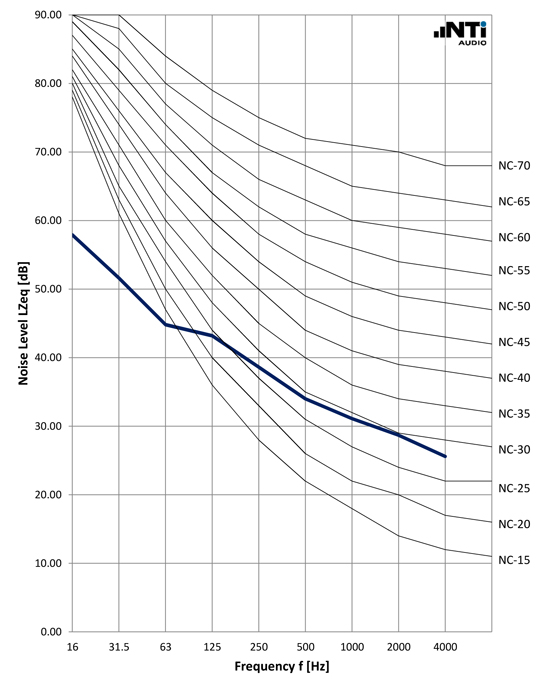
Noise Criteria NC30
Room Noise Criteria RNC(in accordance with ANSI S12.2-2008)
The RNC method is used to determine noise ratings when the noise from heating, ventilating and air-conditioning (HVAC) systems at low frequencies is high, and which is also suspected of containing sizeable fluctuations or surging. It essentially represents a rumble criterion. The RNC curves also provide a procedure that reduces the result essentially back to the NC curves when systems are well designed and acoustically well-behaved. 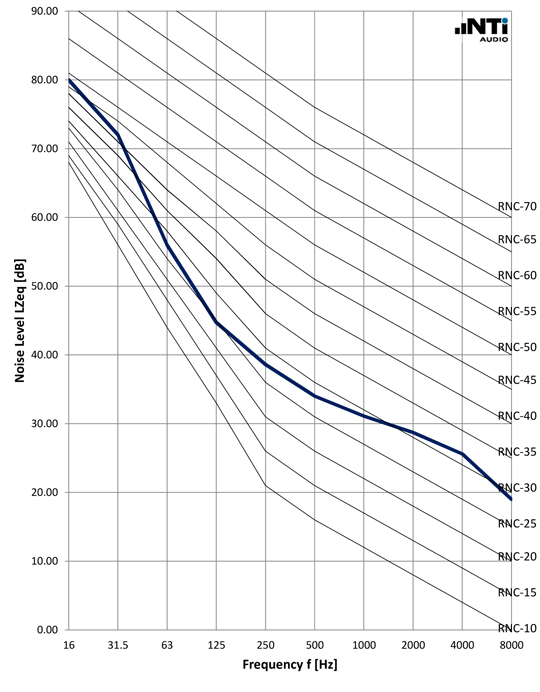
Room Noise Criteria RNC48
Room Criteria RC(in accordance with ANSI S12.2-1995)
The RC criterion curves are a system for use in the design of heating, ventilating and air-conditioning (HVAC) systems in office buildings, dwelling units, etc., where the desired mid-frequency levels are in the range of 25 to 50 dB. Each RC criterion curve bears a rating number equal to the level at 1000 Hz. Spectrum classification - Neutral spectrum (N): The levels at 500 Hz and below do not exceed the RC curve corresponding to a sound level spectrum by more than 5 dB; and the spectrum levels in Band 1000 Hz and higher do not exceed the corresponding RC curve by more than 3 dB.
- Rumble (R): Excessive noise in low-frequency band. The level in one or more of the octave bands at and below 500 Hz exceeds the RC curve corresponding to a spectrum by more than 5 dB.
- Hiss (H): Excessive noise in high-frequency bands. The level in one or more of the octave bands at and above 1000 Hz exceeds the RC curve corresponding to a spectrum by more than 3 dB.
- Vibration and rattle (RV): The level in one or more of the octave bands from 16 Hz through 63 Hz exceeds the criterion for moderately noticeable rattle.
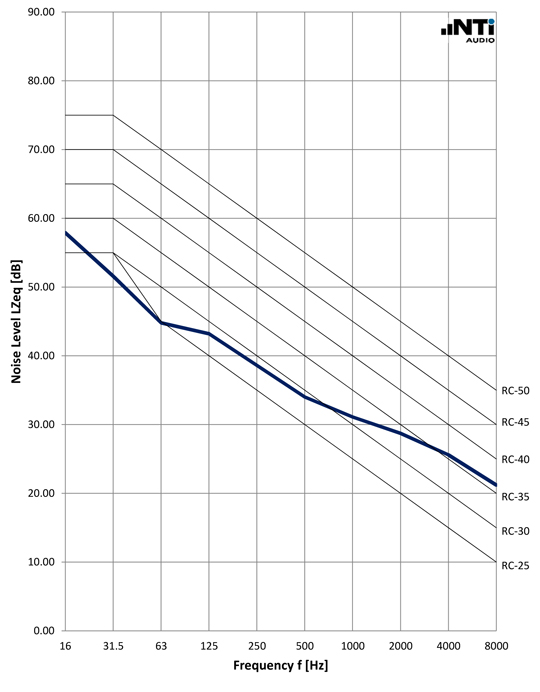
Room Criteria RC32
Preferred Noise Criteria PNC(in accordance with ASA 1971)
The American Statistical Association (ASA) defines the PNC curves as an extension of the basic Noise Criteria system. They have been used in the past to judge the acceptability of ventilation and other background broadband noise. PNC curves are less often used than Noise Criteria curves because they are more stringent at lower frequencies than the Noise Criteria curves, and also because the latest (2008) version of Noise Criteria curves includes an extended frequency range somewhat mitigating the original motivation for PNC. 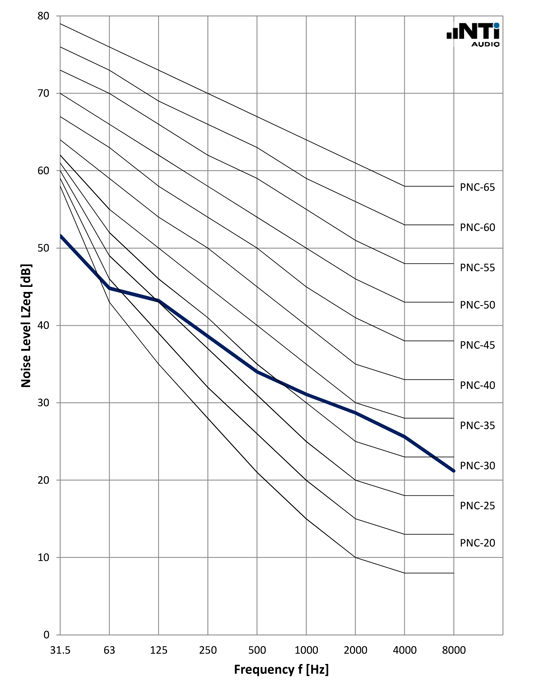
Preferred Noise Criteria PNC34
RecommendationsThe standard ANSI/ASA S12.2-2008 recommends the following criterias:
Type of Room | NC and RNC Curve | RC Curve | | Concert halls, opera houses | 15-18 | - | | Small auditoriums (≤500 seats) | 25-30 | - | | Large auditoriums, churches (>500 seats) | 20-25 | - | | TV and broadcast studios | 15-25 | - | | Legitimate theaters | 20-25 | - | | Private residences: Bedrooms | 25-30 | 25-30 (N) | | Private residences: Living rooms | 30-40 | 25-30 (N) | | Schools | 25-35 | 25-40 (N) | | Hotels: Suites | 30-35 | 25-35 (N) | | Hotels: Meeting/banquet rooms | 25-35 | 25-35 (N) | | Hotels: Service support areas | 40-50 | 35-45 (N) | | Offices | 25-40 | 25-35 (N) | | Conference rooms | 25-35 | 25-35 (N) | | Hospitals: Private rooms | 25-30 | 25-35 (N) | | Hospitals: Public areas | 40-45 | 40-50 (N) | | Movie theatres | 30-40 | - | | Small Churches | 30-35 | 25-35 (N) | | Courtrooms | 30-35 | 25-35 (N) | | Libraries | 30-35 | 30-40 (N) | | Restaurants | 40-45 | - | | Light maintenance shops | 45-55 | - | | Shops and garages | 50-60 | - |
[url=https://www.linkedin.com/company/nti-audio-ag][/url]
|